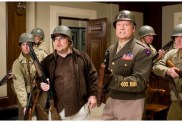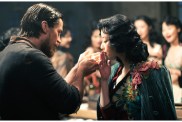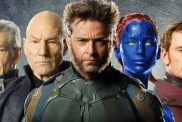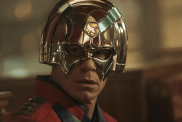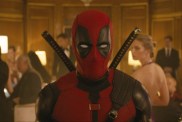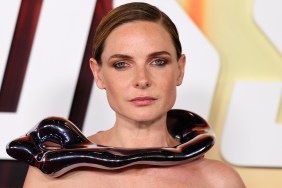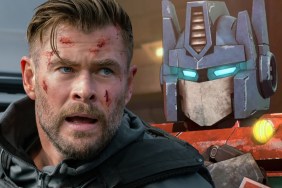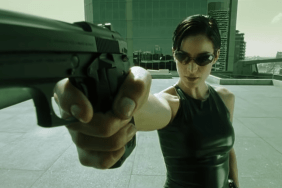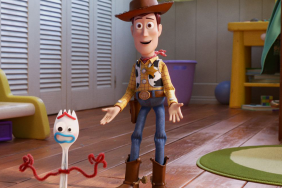ComingSoon.net talks to screenwriter Chris Weitz about the Disney’s Cinderella and Rogue One
The story of Disney’s Cinderella, a poor young woman mistreated by her stepmother and stepsisters only by a twist of fate to have a prince fall in love with her, is pretty well known, because it’s been adapted into many different forms. None are quite as memorable as the classic 1950 animated film, which stirred many young imaginations over the decades since its release.
It was only a matter of time before the modern day Walt Disney Pictures would bring Walt Disney’s animated film to live action, and while a lot of credit for it can be given to director Kenneth Branagh, Cinderella wouldn’t have been quite a surprising pleasure if not for the fairly faithful adaptation by screenwriter Chris Weitz.
Weitz previously directed adaptations of The Golden Compass and The Twilight Saga: New Moon, but that was after years of making movies with his brother Paul, including such influential classics as American Pie and About a Boy.
For those who didn’t get around to seeing Disney’s Cinderella in theaters and don’t know the story, it stars Lily James as Ellla, a pretty young woman who ends up living with her new Stepmother (Cate Blanchett) and stepsisters (Holliday Grainger, Sophie McShera) who basically use her for slave labor. While riding in the woods one day, Ella happens upon a stranger who happens to be the Prince (played by Richard Madden from “Game of Thrones”).
ComingSoon.net spoke with Weitz a few weeks back, and while he couldn’t say much about the current project he was working on, Rogue One: A Star Wars Story, he did talk about the excitement he felt when he got the call and how it was an easy decision to make. (As these things happen, we ended up speaking with Chris Weitz’ brother Paul Weitz just a few days later.)
ComingSoon.net: The Disney animated movie is kind of the benchmark for “Cinderella.” Although there’s been other versions, this one is very faithful. Was that something you decided to go that way or was it Disney that wanted to go that way? What were the original talks about it?
Chris Weitz: Nobody at Disney put down an edict that it had to be (that way), but it just seemed like the trend was towards revisionism and irony in these sorts of movies, so that we wanted to be faithful to the original spirit of the actual 1950 movie, and to be really quite classic and straight ahead to the story, which in and of itself felt like it was out of step with what was going on. The 1950s movie is kind of the imaginative bottleneck through which people understand the Cinderella story, which is thousands of years old and has many different versions and what have you, but it works. Our process was kind of elaboration rather than deconstruction, as it were.
CS: I went on Wikipedia to read about the folktale and there have been so many different iterations of this, even though the Disney movie is the most well-known. Did you actually go back to any of those and read those?
Weitz: Yes, there are so many different versions from different cultures and different versions through time and space, and you’ll find it in all kinds of different languages. You can also find English versions all throughout the years. Every different version has a different take sometimes that kind of relates to the morals of the time, and sometimes it’s about the cultural context in which it’s set. It’s a big story, the idea being that life is rough, but if you hang in there, things can get better. I suppose that’s the moral of it eventually. The 1950s were really idealized and perhaps of not asking too many questions about that, so you don’t really get to know the prince. It’s very obvious to everyone that Cinderella should want to marry the prince because he’s a prince and that’s a good thing. That’s one element that we felt rather free to elaborate on and to try to sort of flesh out, which is to say it was really important to have a prince who was worthy, in our eyes, of somebody like Cinderella, whereas the moral of the 1950 version is where Cinderella is worthy of the prince.
CS: You have things like having her meeting the prince in advance of the ball, which made more sense out of the fantasy. It wasn’t just like, “This is a fairytale, she meets a prince and goes to the ball.” There’s actually a story behind how they initially meet that you build upon.
Weitz: Right. I mean, the thing is nobody really wants to know about the prince, so it’s tricky because the movie is “Cinderella,” so when you have the character of the prince, you sort of have to give him as much resonance as possible in the space that you have, and also, you have to cast somebody who is really, really sympathetic like Richard Madden. He was one of the characters that we felt free to elaborate on, and the stepmother as well. We didn’t really want to go full-on Maleficent with her and have it completely explicable why she was quite so mean. She wasn’t going to become the heroine of the piece, but I think it was important to understand sort of a notion of who she is, especially once we got Cate Blanchett. You can’t help but want to give more humanity to that character.

CS: It’s got to be a lot of fun writing for Cate and the stepsisters. They all had no filter, and you really can let loose in a lot of ways. Did that become more obvious as you were writing it and as the actors came on board?
Weitz: Yes, it’s always fun writing for mean characters, but when specific actors are cast in the role, you start to sort of hear their voice, and that’s terrific in terms of making it more pointed. We sat down with Cate and ran through the lines and worked with her as to what kind of character she wanted to play, which was fantastic. Cate wanted the step-family to be an example of women who didn’t help one another and saw another as competition. I think that was kind of a great way to go with that. It was a huge pleasure for me to be able to write this with a specific actor, especially actors like Cate Blanchett.
CS: I think the prologue is something completely original, because I don’t remember it from the animated film, seeing what happened with Cinderella’s mother and father. I feel like that always started with her with the stepmother and stepsisters and never really got into why she was in that situation.
Weitz: No, you’re exactly right. The parents are very quickly disposed of in the Disney version, and that’s true to the French version of the fairytale as well. To me, it was important that we show where Cinderella came from, in terms of her attitude and her behavior. She’s got tremendous resilience and courage and kindness to her. I thought it was important that she not just be a sort of random occurrence, but that she was an example of someone who has been loved very much by her parents and brought up with a great deal of care and attention. So then Ben Chaplin and Haley Atwell’s characters were really important to the story as it happens, although it makes it all the more kind of unpleasant to kill them off as we did, to show a bit of Cinderella’s childhood.
CS: That was a great segue to my next question, because the line “have courage and be kind” kind of becomes her motto. It’s also something that distinguishes and establishes her as a character in showing how she puts up with all the abuse she gets.
Weitz: Yeah, at one point, we sort of thought, “Well, it would be great to have a motto for the character in the film,” which was to say, not just a kind of a marketing piece, but something that could very quickly sum up what Cinderella was about, not just her, but the movie. It’s a bit rickety and old-fashioned and I think at various points I thought, “Well, I wish I could come up with something better and more clever, but this is where we got to: ‘Have courage and be kind.’” For a while it was “Be kind and have courage,” but then we switched it around. I think Ken thought that the cadences were better, that, “Have courage and be kind.”
CS: I wanted to talk about working with Kenneth Branagh, because he had to somehow bring these magical scenes from the animated movie into live action. When you were writing it were you wondering, “Well, how are we going to do this?” A lot of stuff that’s done in animation would seem impossible to do with live action and even CG these days.
Weitz: The tricky bit in terms of that is the various transformations the fairy godmother brings about, and the great thing is you know that there’s going to be a very talented visual effects crew that’s going to storyboard it and make all that stuff happen. So that’s a lot of weight off of my shoulders, and also, when you have (production designer) Dante Ferretti, you know that the ball scene is going to be pretty magnificent because no matter what, that’s an extraordinary set. I was really amazed when I went to see how many of the sets were actually being built. There’s not a lot being done virtually. In terms of working with Ken, one gets tired of saying how much of a gentleman he is and how fun he is, and it’s true. (laughs) It was a really great experience for me. It was so much fun to work with such a pro and somebody who was so great at putting people at ease. I’m constantly amazed by how much energy that he has, giving that he’s directing “Cinderella,” but then for the next six weeks, he’s going to be playing Macbeth. He’s just this incredible powerhouse of energy. If I were doing that much, I’m sure I would be snippy or difficult at times, but he is never anything but kind and courageous.
In terms of approaching all of these marvelous scenes in the animated film, I think you just sort of take a stab at it. The thing about these big movies is that over time, you have a chance to sort of work out the visuals to storyboard things to rely on the talent of other people as well, specific in flushing things out. So you know, when I saw the first cut of the film, it was really just an astounding and wonderful surprise to see how one or two sentences about a ballroom, and pretty generic ones at that, become something specific and huge and beautiful.
CS: I’ve met Ken and I really like him, but it’s kind of disgusting. He’s so good looking and very articulate and he can act and direct, and he can do everything.
Weitz: (laughs) Right. Yeah, it’s a bit annoying, but it’s all right. I forgive him.

CS: The last time we spoke I felt that maybe you had gotten burnt out on directing and that “A Better Life” might have kind of recharged you a little bit. But you’ve been writing a lot between this and you’re writing the “Star Wars” spin-off “Rogue One.” I was curious about the decision to continue writing big studio movies but not directing as much?
Weitz: I think it was probably an unconscious decision to stick to writing for a while. I now have three children, and directing and children don’t really mix particularly well, whereas with writing, I can spend quite a bit of time at home. I’ve been really, really lucky, and in terms of the stuff that’s come my way. I think “Cinderella” was a big step for me because it was different from the kinds of stuff that I’d been doing, and it was sort of an interesting challenge to write a movie that’s probably going to appeal more to girls more than boys or women more than men. Then Disney controlled every aspect of the culture. It was a way into “Star Wars,” which has been my dream gig since I was about seven years old. If my seven year old self could have seen me working on “Star Wars,” he probably would’ve died of happiness and therefore have never made it to 45. But yeah, I think in terms of directing, every time I work on one of these big movies and write on it and see what the director is being put through, even in the best of circumstances, I think to myself, “Well, you really better not direct unless you’re very, very serious.” So that’s my attitude right now. I’m only going to direct the things I really feel like I have to do.
CS: I wondered about doing “Star Wars.” It has to be one of those things where whatever you’re doing at the time, it must be one of those things that you have to do.
Weitz: Oh yeah.
CS: Three or four years ago, no one thought there was going to be another “Star Wars” movie, period, so the fact that there’s these opportunities to do more is amazing.
Weitz: Right. Yeah, it’s not the kind of job you blow off. You kind of make it happen, at least if you’re somebody like me who saw “Star Wars” for the first time in 1977, and was changed by it. It was the source of my interest in movies in a way. It was the first one that really, really bowled me over. So yeah, absolutely. It was all hands on deck when I got the chance to do it. The key was, sort of in the room when I was interviewing for the job, not appearing to be as excited as I actually was. I wanted people to know that I wasn’t just going to fanboy out 24/7, that I was actually going to be a responsible adult about it.
Disney’s Cinderella is available on Blu-ray, DVD, Digital HD and Disney Movies Anywhere on September 15. You can order your copy by clicking here. Rogue One: A Star Wars Story will open in theaters on December 16, 2016.
Cinderella
-
CINDERELLA

Lily James is Cinderella in Disney's live-action feature inspired by the classic fairy tale, CINDERELLA, which brings to life the timeless images from Disney's 1950 animated masterpiece as fully-realized characters in a visually dazzling spectacle for a whole new generation. -
CINDERELLA

Lily James is Cinderella and Cate Blanchett is the Stepmother in Disney's live-action feature inspired by the classic fairy tale, CINDERELLA, which brings to life the timeless images from Disney's 1950 animated masterpiece as fully-realized characters in a visually dazzling spectacle for a whole new generation. -
CINDERELLA

Cate Blanchett is the Stepmother in Disney's live-action feature CINDERELLA, directed by Kennth Branagh. -
CINDERELLA

Lily James is Cinderella and Richard Madden is the Prince in Disney's live-action feature inspired by the classic fairy tale, CINDERELLA, which brings to life the timeless images from Disney's 1950 animated masterpiece as fully-realized characters in a visually dazzling spectacle for a whole new generation. -
CINDERELLA

-
CINDERELLA

Richard Madden is the Prince and Derek Jacobi is the King in Disney's live-action CINDERELLA, directed by Kenneth Branagh. -
CINDERELLA

Lily James is Cinderella and Richard Madden is the Prince in Disney's live-action feature inspired by the classic fairy tale, CINDERELLA, which brings to life the timeless images from Disney's 1950 animated masterpiece as fully-realized characters in a visually dazzling spectacle for a whole new generation. -
Cinderella0008_0

-
CINDERELLA

Lily James is Cinderella and Helena Bonham Carter is the Fairy Godmother in Disney's live-action CINDERELLA, directed by Kenneth Branagh. -
CINDERELLA

Richard Madden is the Prince and Derek Jacobi is the King in Disney's live-action CINDERELLA, directed by Kenneth Branagh. -
CINDERELLA

Richard Madden is the Prince and Derek Jacobi is the King in Disney's live-action CINDERELLA, directed by Kenneth Branagh. -
CINDERELLA

Lily James is Cinderella and Sophie McShera is Drisella in Disney's live-action feature inspired by the classic fairy tale, CINDERELLA, which brings to life the timeless images from Disney's 1950 animated masterpiece as fully-realized characters in a visually dazzling spectacle for a whole new generation. -
CINDERELLA

Lily James is Cinderella, Holliday Grainger is Anastasia and Sophie McShera is Drisella in Disney's live-action feature inspired by the classic fairy tale, CINDERELLA, which brings to life the timeless images from Disney's 1950 animated masterpiece as fully-realized characters in a visually dazzling spectacle for a whole new generation. -
CINDERELLA

Stellan Skarsgard is the Grand Duke in Disney's live-action feature CINDERELLA directed by Kenneth Branagh. -
CINDERELLA

Lily James is Cinderella, Sophie McShera is Drisella and Holliday Grainger is Anastasia in Disney's live-action feature inspired by the classic fairy tale, CINDERELLA, which brings to life the timeless images from Disney's 1950 animated masterpiece as fully-realized characters in a visually dazzling spectacle for a whole new generation. -
CINDERELLA

Stellan Skarsgard is the Grand Duke and Cate Blanchett is the Stepmother in Disney's live-action feature CINDERELLA directed by Kenneth Branagh. -
CINDERELLA

Cate Blanchett is the Stepmother in Disney's live-action feature CINDERELLA, directed by Kennth Branagh. -
CINDERELLA

Cate Blanchett is the Stepmother in Disney's live-action feature CINDERELLA which brings to life the timeless images from Disney's 1950 animated masterpiece as fully-realized characters in a visually dazzling spectacle for a whole new generation. -
CINDERELLA

Stellan Skarsgard is the Grand Duke and Cate Blanchett is the Stepmother in Disney's live-action feature CINDERELLA directed by Kenneth Branagh. -
CINDERELLA

Lily James is Cinderella and Cate Blanchett is the Stepmother in Disney's live-action feature CINDERELLA which brings to life the timeless images from Disney's 1950 animated masterpiece as fully-realized characters in a visually dazzling spectacle for a whole new generation. -
CINDERELLA

Cate Blanchett is the Stepmother and Sophie McShera is Drisella in Disney's live-action feature CINDERELLA which brings to life the timeless images from Disney's 1950 animated masterpiece as fully-realized characters in a visually dazzling spectacle for a whole new generation. -
CINDERELLA

Holliday Grainger is Anastasia, Cate Blanchett is the Stepmother and Sophie McShera is Drisella in Disney's live-action feature CINDERELLA which brings to life the timeless images from Disney's 1950 animated masterpiece as fully-realized characters in a visually dazzling spectacle for a whole new generation. -
CINDERELLA

Cate Blanchett is the Stepmother in Disney's live-action feature CINDERELLA which brings to life the timeless images from Disney's 1950 animated masterpiece as fully-realized characters in a visually dazzling spectacle for a whole new generation. -
CINDERELLA

Lily James is Cinderella and Richard Madden is the Prince in Disney's live-action feature inspired by the classic fairy tale, CINDERELLA, which brings to life the timeless images from Disney's 1950 animated masterpiece as fully-realized characters in a visually dazzling spectacle for a whole new generation. -
CINDERELLA

Lily James is Cinderella in CINDERELLA , a live-action feature which brings to life the timeless images from Disney's 1950 animated masterpiece as fully-realized characters in a visually dazzling spectacle for a whole new generaton. -
CINDERELLA

Lily James is Cinderella in Disney's live-action feature inspired by the classic fairy tale, CINDERELLA, which brings to life the timeless images in Disney's 1950 animated masterpiece as fully-realized characters in a visually-dazzlling spectacle for a whole new generation. -
CINDERELLA

Lily James is Cinderella in Disney's live-action feature inspired by the classic fairy tale, CINDERELLA, which brings to life the timeless images in Disney's 1950 animated masterpiece as fully-realized characters in a visually-dazzlling spectacle for a whole new generation. -
CINDERELLA

Lily James is Cinderella in Disney's live-action feature inspired by the classic fairy tale, CINDERELLA, which brings to life the timeless images in Disney's 1950 animated masterpiece as fully-realized characters in a visually-dazzlling spectacle for a whole new generation. -
CINDERELLA

Lily James is Cinderella in Disney's live-action feature inspired by the classic fairy tale, CINDERELLA, which brings to life the timeless images in Disney's 1950 animated masterpiece as fully-realized characters in a visually-dazzlling spectacle for a whole new generation. -
CINDERELLA

Lily James is Cinderella in Disney's live-action feature inspired by the classic fairy tale, CINDERELLA, which brings to life the timeless images in Disney's 1950 animated masterpiece as fully-realized characters in a visually-dazzlling spectacle for a whole new generation. -
CINDERELLA

Richard Madden is the Prince in Disney's live-action feature inspired by he classic fairy tale, CINDERELLA, which is directed by Kenneth Branagh and opens in theaters nationwide on March 13, 2105.
-
CINDERELLA

Lily James is Cinderella and Richard Madden is the Prince in Disney's live-action feature inspired by the classic fairy tale, CINDERELLA, which brings to life the timeless images in Disney's 1950 animated masterpiece as fully-realized characters in a visually-dazzlling spectacle for a whole new generation.
-
CINDERELLA

Lily James is Cinderella in Disney's live-action feature inspired by the classic fairy tale, CINDERELLA, which brings to life the timeless images in Disney's 1950 animated masterpiece as fully-realized characters in a visually-dazzlling spectacle for a whole new generation.
-
CINDERELLA

-
CINDERELLA

Lily James is Cinderella in Disney's live-action feature inspired by the classic fairy tale, CINDERELLA, which brings to life the timeless images in Disney's 1950 animated masterpiece as fully-realized characters in a visually-dazzlling spectacle for a whole new generation.
-
CINDERELLA

Cate Blanchett is the Stepmother in Disney's live-action feature inspired by the classic fairy tale CINDERELLA, which is directed by Kenneth Branagh and opens in theaters nationwide on March 13, 2014.
-
CINDERELLA

Cate Blanchett is the Stepmother and Lily James is Cinderella in Disney's live-action feature inspired by the classic fairy tale CINDERELLA, which is directed by Kenneth Branagh and opens in theaters nationwide on March 13, 2014.
-
CINDERELLA

Cate Blanchett is the Stepmother, Lily James is Cinderella, Holliday Grainger is Anastasia and Sophie McShera is Drisella in Disney's live-action feature inspired by the classic fairy tale CINDERELLA, which is directed by Kenneth Branagh and opens in theaters nationwide on March 13, 2014.
-
CINDERELLA

Lily James is Cinderella and Richard Madden is the Prince in Disney's live-action feature inspired by the classic fairy tale, CINDERELLA, which brings to life the timeless images in Disney's 1950 animated masterpiece as fully-realized characters in a visually-dazzlling spectacle for a whole new generation.
-
CINDERELLA

Lily James is Cinderella and Richard Madden is the Prince in Disney's live-action feature inspired by the classic fairy tale, CINDERELLA, which brings to life the timeless images in Disney's 1950 animated masterpiece as fully-realized characters in a visually-dazzlling spectacle for a whole new generation.
-
CINDERELLA

Lily James is Cinderella and Richard Madden is the Prince in Disney's live-action feature inspired by the classic fairy tale, CINDERELLA, which brings to life the timeless images in Disney's 1950 animated masterpiece as fully-realized characters in a visually-dazzlling spectacle for a whole new generation.
-
CINDERELLA

Cate Blanchett is the Stepmother and Lily James is Cinderella in Disney's live-action feature inspired by the classic fairy tale CINDERELLA, which is directed by Kenneth Branagh and opens in theaters nationwide on March 13, 2014.
-
Cinderella

-
Cinderella0013

-
Ella Prince Big Cinderella

-
Cinderella

-
20b4ef1a2b80005f_godmother Xxxlarge_2x

-
Cinderella

